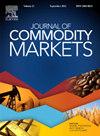全球能源市场的日内波动传导:贝叶斯非参数方法
IF 4.5
4区 经济学
Q1 BUSINESS, FINANCE
引用次数: 0
摘要
我们为国际能源市场指定了一个波动传导模型,该模型将全球交易日划分为三个不同的交易区,使我们能够研究Engle等人(1990)提出的热浪和流星雨假说。由此产生的多元GARCH模型使用具有非高斯创新的高度灵活的半参数贝叶斯框架来指定,旨在处理金融时间序列中的不对称性和重尾。石油和天然气期货市场的实证结果表明,波动率传导是与同一地区的波动率和前一地区的波动率相关的效应的组合。此外,考虑肥尾行为不仅可以显著提高样本内拟合,还有助于揭示额外的跨市场(或跨国)效应,并使我们进一步了解能源冲击在全球传播的确切渠道。最后,在非高斯框架内考虑热浪和流星雨的影响,可以大大提高风险价值估计的准确性。本文章由计算机程序翻译,如有差异,请以英文原文为准。
Intraday volatility transmission in global energy markets: A Bayesian nonparametric approach
We specify a volatility transmission model for international energy markets that divides a global trading day into three distinct trading zones, allowing us to investigate the heat wave and meteor shower hypotheses proposed in Engle et al. (1990). The resulting multivariate GARCH model is specified using a highly flexible semiparametric Bayesian framework with non-Gaussian innovations, designed to deal with asymmetry and heavy tails found in financial time series. The empirical results for the oil and natural gas futures markets suggest that volatility transmission is a combination of effects that are both related to volatility in the same region and volatility in the region immediately preceding it. Furthermore, accounting for the fat-tailed behavior not only dramatically improves the in-sample fit, but also helps to uncover additional cross-market (or cross-country) effects and gives us further insights into the exact channels through which energy shocks are transmitted throughout the world. Finally, accounting for both heat wave and meteor shower effects within a non-Gaussian framework leads to substantial improvements in the accuracy of Value-at-Risk estimates.
求助全文
通过发布文献求助,成功后即可免费获取论文全文。
去求助
来源期刊

Journal of Commodity Markets
Multiple-
CiteScore
5.70
自引率
2.40%
发文量
53
期刊介绍:
The purpose of the journal is also to stimulate international dialog among academics, industry participants, traders, investors, and policymakers with mutual interests in commodity markets. The mandate for the journal is to present ongoing work within commodity economics and finance. Topics can be related to financialization of commodity markets; pricing, hedging, and risk analysis of commodity derivatives; risk premia in commodity markets; real option analysis for commodity project investment and production; portfolio allocation including commodities; forecasting in commodity markets; corporate finance for commodity-exposed corporations; econometric/statistical analysis of commodity markets; organization of commodity markets; regulation of commodity markets; local and global commodity trading; and commodity supply chains. Commodity markets in this context are energy markets (including renewables), metal markets, mineral markets, agricultural markets, livestock and fish markets, markets for weather derivatives, emission markets, shipping markets, water, and related markets. This interdisciplinary and trans-disciplinary journal will cover all commodity markets and is thus relevant for a broad audience. Commodity markets are not only of academic interest but also highly relevant for many practitioners, including asset managers, industrial managers, investment bankers, risk managers, and also policymakers in governments, central banks, and supranational institutions.
 求助内容:
求助内容: 应助结果提醒方式:
应助结果提醒方式:


